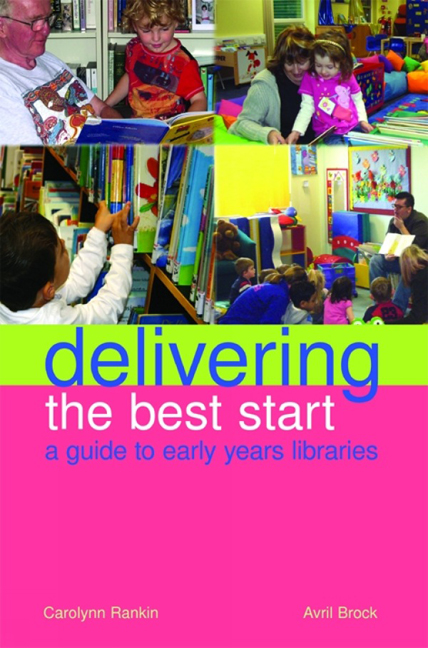Book contents
- Frontmatter
- Contents
- Preface
- Introduction
- Acknowledgements
- 1 Take them to the library – setting the scene
- 2 People and partnerships, skills and knowledge
- 3 Buildings, design and space
- 4 Resources for early years libraries – books, toys and other delights
- 5 Reaching your audience – the librarian's role
- 6 Planning
- Appendix: Early Years Library Services fit with central provision
- References
- Index
3 - Buildings, design and space
Published online by Cambridge University Press: 08 June 2018
- Frontmatter
- Contents
- Preface
- Introduction
- Acknowledgements
- 1 Take them to the library – setting the scene
- 2 People and partnerships, skills and knowledge
- 3 Buildings, design and space
- 4 Resources for early years libraries – books, toys and other delights
- 5 Reaching your audience – the librarian's role
- 6 Planning
- Appendix: Early Years Library Services fit with central provision
- References
- Index
Summary
Introduction
This chapter addresses the role of the library building as an important place in the community. It also considers the environment and design of the space within the early years library. It is important to create a welcoming atmosphere and the ambience, layout, design, furniture and fittings will have a part to play. We will encourage you to think about how you use colour, and how the books and resources are displayed. The design approaches that libraries have used will be discussed. We will consider what makes for a good design in an early years library and suggest how you negotiate with architects and designers to achieve this.
Since the government's Better Public Building initiative was launched (CABE, 2003) we have seen high-quality building design result in some outstanding new schools, libraries, hospitals and transport infrastructure. Too many new public buildings, however, still fall short of the high standards expected. Improved public buildings with good design provide a better environment for staff and, more importantly, for the members of the public who make use of the services and facilities. To ensure that your library provides the best possible environment for the babies, children and adults who patronize it, it is important to take the time to consider the most appropriate and user-friendly layout, structure and design of the building.
A well designed building has a greater value to all involved:
Architecture and design does matter – it communicates identity and values.
A sense of place encourages social cohesion. It is a vital part of quality of life.
(David Lammy, Culture Minister, speaking in 2006)Why should early years librarians be concerned about architecture and design?
The question inevitably arises: why should early years librarians be concerned about architecture and design? You may well be thinking: ‘I'm only involved as part of the team delivering services once the building is already constructed. The design issues are the concern of senior managers.’ However, the current trend for multi-disciplinary teamwork means that you could have the unique opportunity to have input into a new project and be part of designing a building that suits the purpose you have in mind. Avoid being involved in the design and planning of the early years library, and the result could be the creation of an area that you find unsatisfactory and unsuitable for your requirements.
- Type
- Chapter
- Information
- Delivering the Best StartA Guide to Early Years Libraries, pp. 55 - 80Publisher: FacetPrint publication year: 2013



